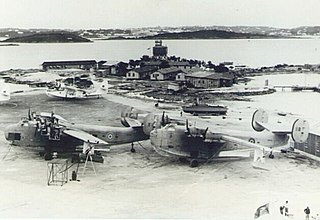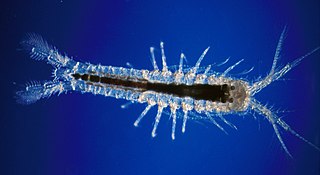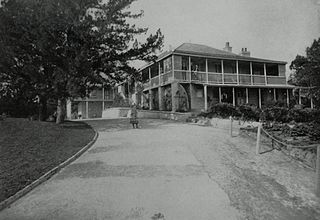
Bermuda is a British Overseas Territory in the North Atlantic Ocean. The closest land outside the territory is in the American state of North Carolina, about 1,035 km (643 mi) to the west-northwest.

The North America and West Indies Station was a formation or command of the United Kingdom's Royal Navy stationed in North American waters from 1745 to 1956, with main bases at the Imperial fortresses of Bermuda and Halifax, Nova Scotia. The North American Station was separate from the Jamaica Station until 1830 when the two combined to form the North America and West Indies Station. It was briefly abolished in 1907 before being restored in 1915. It was renamed the America and West Indies Station in 1926. It was commanded by Commanders-in-Chief whose titles changed with the changing of the formation's name, eventually by the Commander-in-Chief, America and West Indies Station.

Kindley Air Force Base was a United States Air Force base in Bermuda from 1948–1970, having been operated from 1943 to 1948 by the United States Army Air Forces as Kindley Field.

The Hamilton Princess & Beach Club, A Fairmont Managed Hotel is one of the grandest and most famous hotels in Bermuda, located in Pembroke Parish just outside the City of Hamilton. It also happens to be the oldest hotel in the Fairmont chains. One of the largest in Bermuda, it has over 400 rooms. It is one of two Fairmont Hotels on the island, the second being the Fairmont Southampton, which was originally opened as the Southampton Princess.

Ireland Island is the north-westernmost island in the chain which comprises Bermuda. It forms a long finger of land pointing northeastwards from the main island, the last link in a chain which also includes Boaz Island and Somerset Island. It lies within Sandys Parish, and forms the northwestern coast of the Great Sound. It is regarded as one of the six principal islands of Bermuda, and part of the West End of the archipelago.

Darrell's Island is a small island within the Great Sound of Bermuda. It lies in the southeast of the sound, and is in the north of Warwick Parish. The island is owned by the Bermuda Government.

HMD Bermuda was the principal base of the Royal Navy in the Western Atlantic between American independence and the Cold War. The Imperial fortress colony of Bermuda had occupied a useful position astride the homeward leg taken by many European vessels from the New World since before its settlement by England in 1609. French privateers may have used the islands as a staging place for operations against Spanish galleons in the 16th century. Bermudian privateers certainly played a role in many English and British wars following settlement, with its utility as a base for his privateers leading to the Earl of Warwick, the namesake of Warwick Parish, becoming the most important investor of the Somers Isles Company. Despite this, it was not until the loss of bases on most of the North American Atlantic seaboard threatened Britain's supremacy in the Western Atlantic that the island assumed great importance as a naval base. In 1818 the Royal Naval Dockyard, Bermuda officially replaced the Royal Naval Dockyard, Halifax, as the British headquarters for the North America Station (which would become the North America and West Indies Station after absorbing the Jamaica Station in 1830.

The Royal Air Force (RAF) operated from two locations in the Imperial fortress colony of Bermuda during the Second World War. Bermuda's location had made it an important naval station since US independence, and, with the advent of the aeroplane, had made it as important to trans-Atlantic aviation in the decades before the Jet Age. The limited, hilly land mass had prevented the construction of an airfield, but, with most large airliners in the 1930s being flying boats, this was not initially a limitation.

The former US Naval Air Station Bermuda Annex was located on Morgan's Point, a peninsula that had been created by the United States Navy between 1941 and 1943 by infilling between Morgan's Island, Tucker's Island, and the Main Island to create what was originally known as the Naval Operating Base Bermuda. This was a joint surface vessel and seaplane base that ultimately became an annex to the Naval Air Station Bermuda between 1970 and the closure of all US bases in Bermuda in 1995. It was returned to Bermuda in 1995 with the premature termination of the US Navy's 99 year lease. The base had functioned as a way station for ships and seaplanes for over 50 years but the end of the Cold War saw cutbacks in troop deployment throughout the world and the base was no longer needed

Naval Air Station Bermuda, was located on St. David's Island in the British Colony of Bermuda from 1970 to 1995, on the former site of Kindley Air Force Base. It is currently the site of Bermuda International Airport.

The following is an alphabetical list of topics related to the British Overseas Territory of the Bermuda Islands.

The National Museum of Bermuda, previously the Bermuda Maritime Museum from its opening in 1974 until 2009, explores the maritime and island history of Bermuda. The maritime museum is located within the grounds of the fortress Keep of the former Royal Naval Dockyard in Sandys Parish on the Ireland Island at the western end of Bermuda. The museum publishes a number of books relating to Bermuda's history.
Watford Island is an island of Bermuda.

9 Beaches was a resort in Sandys Parish on the west end of Bermuda featuring access to nine beaches. This was historically Admiralty land, part of which was purchased in 1809 with more acquired in 1914 and 1915 for a Wireless Telegraphy station, and was transferred from the Royal Navy to the Royal Canadian Navy in 1963. The station closed in 1995 and the property was earmarked for tourism use.

The United States Naval Station Whites Island was a United States Navy (USN) facility located on White's Island in Hamilton Harbour, in the British Colony of Bermuda, 640 miles off the coast of North Carolina.

The Bermuda Base Command was a command of the United States Army, established to defend the British Colony of Bermuda, located 640 miles off Cape Hatteras, North Carolina. It was created in April 1941 when United States Army troops were sent to the island.

Admiralty House, Bermuda, was the official residence and offices for the senior officer of the Royal Navy in the Imperial fortress colony of Bermuda, originally the Commander-in-Chief of the North America and West Indies Station.

HMS Castle Harbour was a civilian harbour vessel of 730 tons that was taken-up from trade (TUFT) during the Second World War by the Royal Naval Dockyard in Bermuda for use by the Royal Naval Examination Service and later armed and commissioned as a warship, providing harbour defence from submarines.

Imperial fortress was the designation given in the British Empire to four colonies that were located in strategic positions from each of which Royal Navy squadrons could control the surrounding regions and, between them, much of the planet.
















